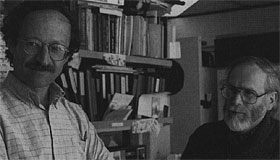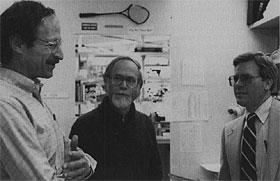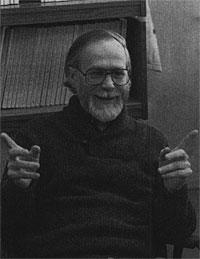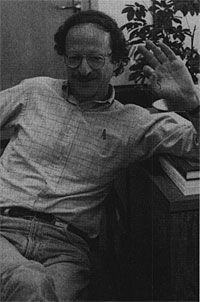Interview: Harold Varmus and Michael Bishop

In 1989, Harold Varmus (left) and Michael Bishop (right) of the University of California, San Francisco, shared the Nobel Prize in physiology and medicine for their discovery of genetic changes that can cause cancer. This interview reveals a passion for science that characterizes the best researchers and the best teachers. Professors Bishop and Varmus teach medical students and graduate students at the University of California, San Francisco, in addition to directing research laboratories that study viruses and cancer genes. They are also active in the university's Science Education Project, which provides hands-on laboratory experience for elementary and secondary teachers in the San Francisco area.
How did each of you first hear the news of your Nobel Prize?
Varmus: Almost everybody in the United States who hears about the Nobel Prize hears about it in the same way. Someone calls you in the middle of the night: a reporter who's spreading the word and very eager to be the first person to give you a phone call.
Bishop: It's a shame that the people who award the prize are hardly ever now the first to tell you. They hold a press conference at noon in Stockholm, which is 3 a.m. in California. It goes out on the wires immediately, and within ten minutes the people in New York are on the horn trying to reach the winners. So you almost always hear from the press. It's an interesting reflection of how much more seriously the press and the public take this prize than other prizes in science.
What were your initial feelings when you got those middle-of-the-night calls?
Bishop: When the phone rang that early in the morning, despite some initial anxieties that it might be trouble in the family, it did cross my mind that, good grief, it is October (the time the prize is traditionally awarded). I can't admit to any immediate exhilaration. My first thought was, "I'm hardly awake and some reporter is going to ask me to explain this work and it's 3:15 in the morning." What a ridiculous circumstance to have to give out your first international sound bites. I didn't start to enjoy it until we had gotten rid of the first round of phone calls, which took an hour or so. It wasn't a total surprise because Harold and I knew that we had been in contention for some years. It's not something we ever discussed, in all candor, but we knew.
Varmus: People always ask how you learned about your prize, but what I find more interesting is how people learn about the Nobel Prize as an institution in the first place and what it means to them. In my own life that was actually fairly significant. I was about 13 and I was looking around for topics for a public speaking contest and my father, who was a doctor, said, "You ought to learn something about this man John Enders, who recently won the Nobel Prize." I didn't know what the Nobel Prize was, so I was sent off to the library to read a few things about Enders. What I found interesting was that this was a man who didn't cure anything, but developed the technology for growing poliovirus, setting the stage for the polio vaccine. And I learned that the Nobel Prize awards contributions to basic science made without any necessary, explicit practical goal but that generate some fundamental piece of information that allows science to move forward.

How did the two of you come together?
Varmus: I was shopping for a place to do postdoctoral work. I'd been at NIH working on a problem in bacterial genetics, and I wanted to move into the area of cancer and learn to work with tumor viruses. I learned that there was a group in San Francisco that was starting to work on tumor viruses, so I came by to see what was going on. I found that Mike had the same kind of approach I was hoping to find. The freshness of getting involved with people who were starting up in a field that was obviously ready for some excitement also was an inducement.
Is it difficult to switch from one research field to another?
Bishop: It takes self-assurance. It takes something bordering on arrogance to do that, because typically the fresh insights seem naive to the experienced. If you read the Watson-Crick story, the people who had been working on the DNA problem were absolutely furious with Watson and Crick at their effrontery in bringing in these simpleminded ideas when everyone knew that this was a complex chemical problem that only a giant like Pauling could solve. Watson and Crick, playing around with little cardboard-and-tin models, nailed it. So it takes a lot of self-assurance, sometimes in a form that others perceive as arrogance, to make the jump. If you stop and look at what you are doing, you say to yourself, "I'm going to make a fool out of myself. I don't know what I'm doing." And yet, the history of science is full of examples of this.
Scientists take risks?
Bishop: Risk taking is important. There are a variety of risks. The most fundamental one is that if you divert some of your energy and research resources to explore something unusual, you have to sustain your overall productivity at the same time. Then there is the fear of failure, the fear of making a fool of yourself in your own eyes. No one else would ever know you ran that experiment, but you'd look at yourself and say, "My goodness, how could I have been so stupid as to think that that would have worked!" So there's the practical risk and a psychological risk. But I think if you look at most of the great breakthroughs in the history of science, they involve what I call intellectual courage. You see it over and over again. People who were absolutely so self-assured that they had just bashed ahead when other people had backed off.
At the time you were doing the research that eventually led to the Nobel Prize, did you realize the great significance of the work?
Varmus: I don't think either of us did. The question that we were working on had been in the air due to the combination of experimental observation and theory described in the late 1960s. The kinds of experimental questions we were asking were not unique. The methods were generally available; the specific applications varied from lab to lab. The way we went about answering the questions turned out to give us clear-cut answers in a way no one else had been able to obtain them. Of course there was a time when our findings were controversial and viewed with skepticism by many. There was a period when it wasn't clear how widespread the phenomenon we were describing actually was, and it took time before the full significance sank in. And it was not only our own work but the work of many others as well that led to the general acceptance of the conclusions we had drawn in our initial papers. So it was a long time before we saw not only that what we said was right but that it was important and prizeworthy. But what Mike and I find more important than the prize is the growth of this field, the basic ideas that come out of it, and the questions that drive us onward.
What was your key discovery that had such an important impact on cell biology?
Bishop: In conceptual terms, what we did was to reveal that there are normal genes in the cell that have the capability to become cancer genes. Typically, they become cancer genes by being damaged; cancer arises from genetic damage in the cells of our bodies as we mature and age. The same genes are also found in certain viruses that can cause cancer in some animals. By studying one kind of virus with a peculiar growth cycle, and by asking where it got its cancer gene, we came upon the first example of explicit genes in normal cells that have the potential to become cancer genes if damaged. We found it in chickens first; in the long run it didn't matter. We had a glimpse of the idea in our minds; there is a suggestion of it in our first paper. But to be able to make the statement as decisively as I just did requires the intervening 10 to 15 years of data.
Varmus: We knew from our medical school background that cancers were likely to be caused by mutations. We knew that cells were very complex with respect to their genetic constituents and that it was difficult to imagine what kind of mutations and what affected genes would lead to the development of a cancer in a human. We also knew that there were viruses in nature that could cause cancer and that viruses were a lot simpler than cells; they have very few genes. In the era before gene cloning, in the late sixties and early seventies, the only way you could lay your hand on one or a few genes explicitly involved in cancer might be to study viruses. So despite the likelihood that viruses were not major causes of cancer in humans, there was tremendous interest in developing experimental models for cancer using viruses.
That idea, of course, was criticized by many who said, "Isn't it ridiculous to try to understand cancer with viruses, when most human cancers probably are not virus-induced? Furthermore, isn't it ridiculous to look at a chicken cancer virus? After all, chickens aren't even mammals. It's very unlikely that what you are looking at is relevant." But it turned out that the virus we were working with, Rous sarcoma virus from chickens, was the only virus that met certain criteria that would allow us to do a decisive experiment about the origin of the gene involved in inducing cancer. Furthermore, the gene that we ended up working with is extremely widespread in nature, and we could ultimately make statements about mammals, including humans, based on work done with the chicken virus.
How do we reconcile a genetic theory of cancer with the observation that environmental hazards can trigger cancer?

Bishop: In the simplest formulation, environmental causes of cancer-cigarette smoke, chemicals in water, whatever-act by damaging genes. Our work laid hands on the first example of the kind of genes that might be damaged in the genesis of cancer.
You mentioned earlier that what's really important now is where this work goes from here. What are the important questions now?
Bishop: We know there are multiple genetic changes involved in causing most, if not all, cancers. And although we can count five or six of these in some tumors (cancer of the human colon is the most well explored so far), in many other instances, we haven't a clue yet what all the changes are, and we don't know whether there is a particular sequence that's essential. And then we need to know how these genes work so we can understand why they give rise to the cancer cell, so that we can think about counteracting their actions in a therapeutic effort. I think those are two of the most important lines of inquiry that will probably flourish over the next decade.
Varmus: I agree those are the two general areas in which information is lacking. We know from work with viruses that there are perhaps 40 or 50 genes that can act during the development of a cancer by overriding the action of a normal copy of the gene. A major concern is the mechanism by which such genes exert their activity. What that means is figuring out exactly what stage in growth or development is influenced by the action of these genes.
Bishop: It's probably worth emphasizing that what's at stake here is not just cancer. The whole farm is at stake. I mean, these genes run the part of the machinery that directs the everyday lives of ourselves from conception to death, and so we're wrestling with problems here that pertain to growth and development of the normal organism as well as the anomaly of cancer. By studying a disease state, we've been led to insights and whole new avenues of study on probably the broadest and grandest problem in biology now: How does one cell become an organism (as ugly and glorious as Homo sapiens!)?
Varmus: The genes that were discovered initially as being cancer-causing genes have been used to identify genes that play a role in virtually every step in growth control: Genes that make factors that are secreted and act as intercellular signals; genes that make the receptors for those signals that fly across the membrane and tell the inside of a cell what the outside of the cell is perceiving; genes that make proteins that translate the signals that are coming into the cell through the receptors; genes that we know have a role in cell division; and genes that function in development of the nervous system. Virtually every process that's of interest in cell biology now has been influenced by some of the genes that have been isolated initially as cancer-causing genes, but in their normal guise play explicit and obviously important roles in growth and development.
Can you envision possible applications of your discoveries in the diagnosis and treatment of cancer?
Varmus: They've already been applied to a very limited extent. There are ways in which knowledge of the small set of genes commonly involved in cancer has affected diagnosis and prognosis. And in those several cases-certain forms of leukemia, certain forms of colon cancer, some childhood cancers-it's possible by asking a molecular question to make a more definitive diagnosis and to stage tumors in a way that's useful for effective prognosis and the design of therapy. I think that will ultimately influence clinical decisions in several areas of oncology.
You've written that progress in cancer research is an unexcelled vindication of fundamental research. Can you expand on this idea?

Bishop: When I first came here, a colleague of mine was studying the Rous sarcoma virus that causes tumors in chickens. There was at the time not a shred of evidence that viruses caused cancer in humans. But just to look through a microscope and watch the transition the cells undergo when a chicken virus infects them was all it took to get me hooked on the problem. I wanted to understand why it happened. I didn't get out of bed in the morning thinking I was going to cure human cancer by studying this. All I said was, "This must be a profound change in a vertebrate cell that's worth understanding." We started to work on it because it was just so fundamentally engaging. It was 15 years before I started to relate what we were doing to the problem of human cancer in anything I wrote or said in public.
You've both had a medical education. What influenced you to become research scientists instead of practicing physicians?
Varmus: I was academically inclined. I went to medical school thinking I was going to end up writing psychoanalytic interpretations of literature. I slid very slowly into research. It was during the Vietnam era and some sort of government service was required. I ended up at NIH, where I was given my first taste of real research. I had dabbled in the past, but not to any serious degree.
I sometimes date my addiction to a day in maybe the third or fourth month I was at NIH. I'd been trying to get a simple assay to work so that I could measure levels of a certain RNA in a bacterial cell. I'd been trying a number of things that gave me very soft results, when suddenly I had a new assay. I remember standing at the scintillation counter, with a few counts in the background and thousands of counts in the positive part of the experiment. I still remember the charge I felt. I didn't have any answers at that point. I just had the tool and I knew the next day the experiments were going to work. It was that thrill that made me feel like . . . I was hooked now. I still had responsibilities for patients and I was just praying that nobody was going to call me from the lab and interrupt a day of joy in the immersion into your own experiments that occurs once you have something powerful to answer questions with. It is really pretty exhilarating. It's as addictive as any drug.
Bishop: I evolved a little more gradually. I went to medical school without a single notion of what I wanted to do, except I was pretty sure that I didn't want to practice medicine. I became interested in a succession of subjects; neurobiology was the earliest. The most important influence was my peers. The faculty could have been on the moon. My peers were a remarkable group of people: articulate, informed, with diverse interests. These people had a respect and knowledge about research that I had not had. I befriended several of them.
I was frustrated and so confused that I took a year off after my second year of medical school with a fellowship to work in a pathology department. I did routine pathology and essentially was fully prepared for the rest of medical school. I dabbled in the research lab. I had read about molecular biology, but I hadn't a prayer of getting into a mainstream molecular biology lab given my background. So in the third year I went looking for a subject that was ready for molecular biology but was untrammeled. And I found animal viruses. I took an elective course on viruses that cause disease in humans and other vertebrates. It was the first time in my life I had ever been required to read the literature and present it, and I was in absolute ecstasy.
Then I hooked up with one of the young instructors, who took me into his lab. I showed up there one Saturday at 9 a.m. He was going to teach me to do the assay for the virus that would allow me to do the experiments that I had decided I wanted to do. It was things I'd cooked up myself, just completely off the wall. We walked out of that place at midnight; between 9 a.m. and midnight he and I had worked together doing this assay. And when I got home, I woke my wife up and said, "I've found it."
It was never the same after that, even though I had to go through two years of clinical training to work my way into the establishment to find research training. I knew from that time on what I wanted to do. I didn't know whether I would be able to do it, whether I'd make it, but I knew what I wanted to do.
How do you view the current state of medical education?
Bishop: There are problems. We don't teach science very well to medical students. It's too didactic. The answer seems to lie somewhere in flexibility and in faculty commitment and involvement, and in getting away from didacticism. But, it's not easy to do. Medical school students are very diverse in their preparation. And most are not engaged by science. They see medicine as some other sort of career. We don't usually succeed in engaging them. We'd like to.
Varmus: A major problem in medical education is the tremendous strain of competing interests. You have an essential core of curriculum. There must be one because students have to come out of medical school knowing about an essential list of diseases, knowing a certain amount of anatomy, fundamental metabolic pathways, and a certain number of drugs. They simply can't be accredited to practice medicine, which is the primary goal of medical education, without exposure to a certain vocabulary and a certain body of knowledge. The demands to teach that body of knowledge are always competing with the specialized interests.
And, of course, a medical school has a huge faculty. Each of us has special interests that we believe are extremely important. I certainly think it would be a sin for a student to leave medical school without at least some exposure to the idea of oncogenes and some notion of how retroviruses grow. After all, they're the cause of AIDS. So we all want our hours of time to teach students.
And then you have the basic issue about what are the best ways to learn: from lectures, from books, from individual projects. And you have the students' demand for getting contact with patients early on. I take a somewhat conservative position here, which leads me to believe that you are perfectly well off delaying that all to the third year of medical school. But the students don't like that. They want to lay hands on early. They also want time off. All these factors make it very difficult to teach not only the fundamentals that are required to be a practitioner of medicine, but also some of the excitement in biology that's applicable to medicine now.
What do you find so alluring about science?
Varmus: People sometimes say to me, "God, you work so damn hard. I respect what you do so much because you're reading all night and you work these incredibly long hours." I feel just the opposite. The kind of attitude that I think has to exist among at least a significant number of scientists is that you are playing. You're asking questions that are interesting and solvable, regardless of what might be their ultimate effect on the marketplace. And there are always new questions. I'm often struck, looking back, at how uninterested I am now in the questions that obsessed me 10 or 15 years ago, because now we have answers to a lot of those questions. What I care about now are the questions that have come out of those answers and the privilege of going out and answering the new questions. There is always the excitement of new questions and people to answer the questions with us.
©2005 Pearson Education, Inc., publishing as Benjamin Cummings